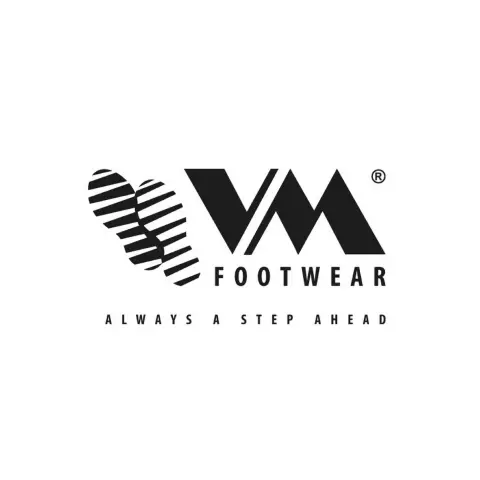VM Footwear REYKJAVIK Safety Ankle Shoes
Product description
safety ankle shoes, with composite toe cap and kevlar midsole, metatarsal shield, hydrophobic leather, Non metallic, PU/Rubber, HRO - black
Indicates the shoe's exterior color, which may align with workplace dress codes, visibility requirements, or practical concerns about dirt visibility.
Indicates whether the footwear has protective reinforcement (Safety) or no special toe protection (Plain), affecting workplace safety compliance and injury prevention.
Offers a breathable and cost-effective in-shoe surface. Provides basic cushioning and moisture absorption for comfortable wear in various work shoes.
Offers balanced cushioning and shock absorption for all-day comfort. PU Foam insoles provide durable support and resilience in demanding work conditions.
Reduces impact on feet and joints, lessening fatigue during long hours on hard surfaces. Provides enhanced comfort for demanding work environments.
Enhances stability on slick surfaces, reducing the risk of slips and falls. Designed for reliable grip and secure footing in various work environments.
The material composition of the shoe's bottom portion that determines slip resistance, durability, and protection against workplace hazards like chemicals, heat, or punctures.
Defines the protective material in the middle layer of the sole, such as Kevlar or metal, providing puncture resistance and underfoot safety in hazardous environments.
Identifies the protective material in the toe cap that shields against impacts and compression. Different materials offer varying levels of protection, weight, and comfort.
The interior fabric that touches your foot, affecting comfort, moisture control, and temperature regulation during long work shifts in demanding environments.
The color of the shoe's bottom surface that affects visibility in low-light conditions, complements uniform requirements, and reflects personal style preferences.
Indicates the exterior color of safety footwear, helping you match workplace dress codes while considering visibility and practicality in your work environment.
- Heat & Flame Resistance
- Impact Resistance
- Electrical Protection
- Slip Resistant
Request a free sample
Test first and buy later. Visit any product page to request your free sample.
Standards and labels
Test results
General Requirements S3The EN ISO 20345:2011 standard specifies the general safety requirements for protective footwear used in various industries. The S3 designation under this standard means the footwear has met certain criteria, including basic toe protection, anti-static properties, energy absorption of the seat region, water resistance, fully enclosed heel, cleated outsole, and penetration resistance by a steel midsole. This classification involves specific test methods like compression and impact tests on toe protection, antistatic resistance tests, energy absorption verification at the heel section, water penetration, and absorption tests to ascertain the upper material's resistance, and penetration resistance tests to ensure the protective features of the outsole and midsole. For industries requiring protective footwear that can withstand mechanical risks, moisture, and sharp objects, achieving an S3 result guarantees a high safety level, making footwear that meets this requirement suitable for environments with increased moisture and at risk of foot penetration by sharp objects.
General Requirements CRThe standard EN ISO 20345:2011 encompasses general requirements for safety footwear to ensure they provide adequate protection in various occupational environments. Rating 'CR' signifies that the footwear has a cut resistant upper ensuring enhanced protection. The test method involves assessing the material's resistance to splitting or cracking under certain conditions, which simulates real-world industrial hazards involving sharp objects or surfaces. Practically, this result ensures that the footwear is suitable for environments where there is a risk of materials splitting or getting caught, thereby providing essential safety benefits to the user.
General Requirements HROThe HRO result listed in the standard EN ISO 20345:2011 pertains to the heat resistance of the outsole of safety footwear. This test result confirms that the outsole is capable of withstanding exposure to high temperatures without degrading its physical properties and performance. The test method requires that the outsole of the footwear be exposed to 300°C for a minimum of 60 seconds under specified conditions, during which the outsole should not melt or crack, ensuring that it continues to provide protection against hot environments. Since the HRO classification attests to heat resistance, this feature is particularly important in industries such as metallurgy or construction, where contact with hot surfaces is a common hazard. Understanding this result can assist procurement professionals in sourcing appropriate safety footwear that meets the required durability and performance in high-temperature working conditions.
VM Footwear delivery terms
Free delivery when you order more than 1 650,00 kr from VM Footwear
Supplier shipping fee 60,00 kr
Brand minimum 0,00 kr
877,58 kr
Price per pair
877,58 kr / pair
Shipping fee is 60,00 kr for orders under 1 650,00 kr
Sold in units of one pair
Need larger quantities?
Other products you may like
Recently viewed
Need help?
Get help from our experts
Other products you may like
Similar products you may like
Recommended for you
VM Footwear
Delivery time: 5 business days
Supplier shipping fee 60,00 €
Free shipping on orders over 1 650,00 €



Find +150,000 products from hundreds of brands
Autonomous sourcing platform
The most efficient way to source and order supplies for your operations
Sourcing
Ordering
List products you’re looking for and we’ll find the best products and prices for you – all for free.
Need help?
Get help from our experts
